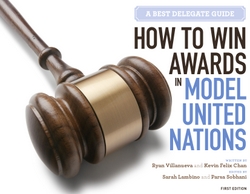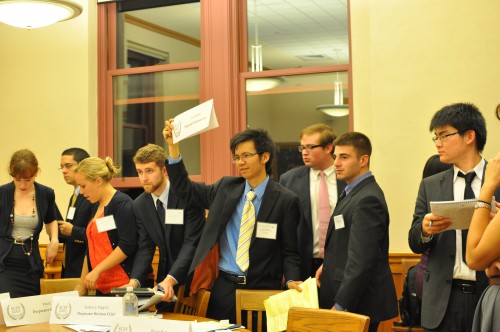I was doing some private coaching the other day and the student remarked “it seems like everyone just keeps repeating the same facts and policies during the opening speeches but then all of a sudden the advanced delegates come out with draft resolutions from nowhere. How do delegates get from speeches to starting on their resolutions?”
There are two lessons here (assuming that delegates did not pre-write those resolutions). The first lesson is that there are 5 Stages of Committee and delegates may be operating in different stages. The second lesson is that delegates should always aim to push debate forward in all stages, and there are different ways to do this during Opening Speeches, Caucusing, Writing Resolutions, and Debating Resolutions.
The first lesson is the 5 Stages of Committee which refers to a hidden process in the flow of debate and you have to learn how to feel which stage the committee is in and when it should move onto another stage. For example, speeches are made throughout the entire committee, but that does not necessarily mean speeches are as important during some stages as they are in others. The advanced delegates figured this out — their time is better spent writing draft resolutions with others outside the committee or writing a portion of it at their desks (if they’ve divided up the clauses) than to listen to some of the speeches if they’ve already figured out which countries to work with.
But the second lesson is that delegates should always push debate forward because the ultimate goal of the committee is to come up with a resolution that contains ideas on how to solve the problem. Repeating information that everyone already knows does not accomplish this. Even a better speech formula of “agree or disagree and explain why” does not cut it because it does not tell what others should do about your opinion or what you want to do with an idea that you agree or disagree on.
Here is how to properly push debate forward during different stages:
1. Opening Speeches Stage: Your opening speech should always be framed. That means your speech is structurally organized so that delegates can easily remember the three main points of your speech. And those three main points should be used to tell the rest of the committee which issues you think everyone should focus on. This is pushing debate forward — you’re telling others to work on sub-issue A, B, and C instead of all the other ones that were mentioned in the background guide. This will help brand you as the country that wants to work on those issues and make it easier to find allies with similar policies or a focus on similar issues.
2. Caucusing Stage: Caucusing should not only be used to find allies that have similar policies and want to work with you. In addition to doing that, caucusing should be spent discussing how everyone in the same bloc will work together. Which issues will our bloc be addressing? What are the big-picture solutions that we plan to propose? Which countries to focus on which operative clauses? (Remember to always assign yourself the hedgehog clauses — buy the How to Win Awards book if you don’t know what that is yet). This is pushing debate forward — you’re telling others what to work on in order to make caucus productive.
3. Writing Resolutions Stage: Writing resolutions should not only be about your primary ideas. Once the main operative clauses have been written, it is time to back them up with details that will improve and strengthen each clause. You push debate forward by getting the authors — including yourself — to invite and respond to the criticism on your draft resolution by opposing blocs by adding in details and sub-operative clauses that will improve your draft resolution. You already know what all the sponsors agree on in the draft resolution so you push debate forward by finding out what other people think about it and turning their ideas or criticisms into improvements or amendments on your own draft resolution.
4. Debating Resolutions Stage: Debating resolutions is about accomplishing your ultimate goal — to get your draft resolution passed. Once your draft resolution has been written and already improved through editing and perhaps even amendments, it’s time to sell your draft resolution to others (or defending it against criticism) so that they are in favor of voting for it. In this stage, you push debate forward by explaining ultimately why delegates should vote or should not vote for certain draft resolutions. Speeches, comments, and moderated caucuses still exist during this stage, but instead of just explaining what’s on your draft resolution, you should explain what makes it better than everyone else’s resolutions.
**
Get the “How to Win Awards” Guide Today!




